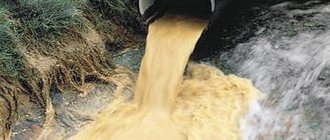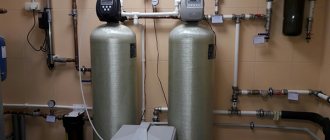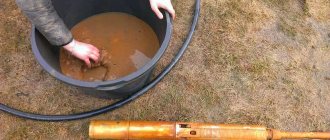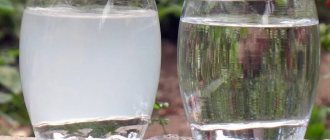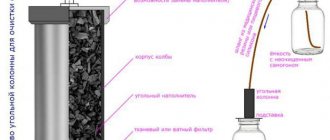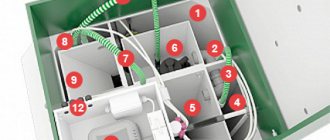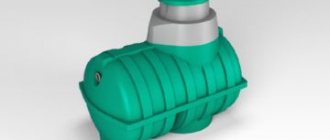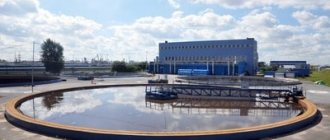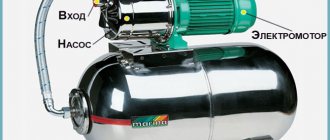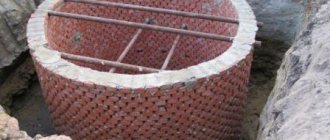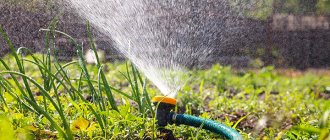Today we will look at the main issues regarding the selection of such installations.
- What are the advantages and disadvantages of aeration plants?
- How do installations from different manufacturers differ?
- How to determine the required volume of an aeration unit?
- Is it worth separating “black” and “gray” wastewater?
The operation of these stations is based on the aerobic process of biological wastewater treatment. In other words, organic substances are decomposed by microorganisms that use air oxygen for their vital functions, with which the wastewater is saturated using a compressor or drainage pump.
What are the advantages of aeration units?
- High degree of wastewater treatment, reaching 95-98%. In this connection, manufacturers of VOCs allow the possibility of discharging purified process water from their structures onto the terrain - into a village drainage ditch, ditch, nearby forest, reservoir, etc. This is a significant advantage of VOCs over septic tanks that require additional treatment of wastewater in soil filtration structures (about septic tanks from concrete rings, plastic septic tanks and filter structures for them, we described in detail in our articles).
- Aeration units are the best option for autonomous sewerage when the site has clay soils with poor filtering capacity. That is, when it is very difficult to arrange filter structures. Or when there is simply no room for them on the site. This means that the option of a septic tank is eliminated.
- Aeration units are suitable for areas with heaving soils and high groundwater levels (GWL). Such installations are made of plastic - most often polypropylene or fiberglass - in a factory. Therefore, they have a durable and sealed body, equipped with stiffening ribs and protruding elements. This allows the VOC to avoid deformation and extrusion onto the surface.
- Compared to septic tanks, aeration systems less often have to be cleaned of excess sludge. But you still need to pump it out.
Septic tank installation
The Eurolos Pro aeration unit must be immersed in a pit dug in the ground in a strictly vertical position. At the bottom of the pit it is necessary to prepare a sand cushion and level it. After connecting the AC network and sewer pipes to the station, the free space of the pit is filled with sand or a mixture of cement and sand; the topmost layer can be sprinkled with soil for planting a lawn.
Eurolos Pro installation video
Documentation
Technical data sheet Eurolos PRO
, pdf file ~1977.82Kb
Wiring diagrams
Eurolos PRO installation diagrams
, pdf file ~305.23Kb
What are the disadvantages of aeration plants?
- Quite a high cost, especially for high-quality products.
- Relative complexity of the design: there are moving elements.
- Energy dependence. Although the energy consumption for VOC operation is relatively small, when the power is turned off, the installation quickly ceases to function normally.
- Unstable work under the condition of non-permanent residence in the house, which means uneven flow of wastewater.
- The need to preserve the installation for the winter if you do not intend to live in the house at this time of year.
- VOCs require regular maintenance (often 3-4 times a year), which can be a hassle for homeowners.
- Compared to septic tanks, aeration systems are not as “omnivorous”: there are serious restrictions on what can be discharged into the sewer. Most often, you cannot dispose of leftover vegetables and fruits, spoiled food, construction waste, filter rinses, large amounts of wastewater containing chlorine-containing products, etc. There, however, you can throw toilet paper, kitchen drains, and drains from dishwashers or washing machines there.
Sergey ShemaevCEO
When preserving an aeration plant for the winter, it is strictly forbidden to pump water out of it, otherwise the station may be deformed or squeezed out onto the surface of the earth. To avoid this, be sure to leave the unit filled with clean water.
Interesting Facts:
•
The rate of bacterial growth is enormous.
If there are no factors limiting their growth, with sufficient nutrition, 1 mg of bacterial colonies per day can reach a weight of 10 tons. This process is regulated by the amount of nutrients and the presence, as a rule, of protozoa in the suspension. •
The total area of 1 g of bacteria in dry form reaches 100 m2, which explains such a large absorbing capacity of activated sludge.
In the secondary settling tank, dead or excess activated sludge colonies settle. As a result of active division, bacteria double their number every 30 minutes. The death of colonies occurs due to several reasons: • Due to lack of nutrients and oxygen; • Due to temperature changes, composition of incoming wastewater and other stress factors; • At the end of the natural life span.
How do installations from different manufacturers differ?
There are two main types of VOCs depending on whether aeration is carried out using a compressor or a sump pump. There are significantly more stations of the first type on the market. This is due to the time-tested efficiency of fine bubble aeration that the compressor provides.
Installations of this type are represented by the trademarks Tver, Topas, Astra, Eurolos (PRO series), Eco-Grand, BioDeka, etc. In general, the principle of their operation is similar. The wastewater passes sequentially through several chambers.
First, they settle in the receiving chamber, then enter the aeration tank - a chamber where they are saturated with oxygen from the air. Air is supplied through a fine-bubble aerator connected by a tube to a compressor. Thanks to oxygen, intensive reproduction of microorganisms already contained in wastewater occurs. Some VOC models are supplemented with bioreactors (loads) that promote the proliferation of these microorganisms. As a result, activated sludge is formed, which destroys organic compounds present in the wastewater.
Next, the clarified water with sludge particles is sent to another settling tank, where the sludge settles and again enters the aeration tank. And the purified water enters the next chamber, from where it is discharged outside the station - by gravity or forcibly, using a pump. Depending on the installation model, liquid movement occurs either by airlifts (jet pumps), or in combination - by gravity and airlifts. Some VOC models provide additional settling chambers, as well as a bioreactor (loading) in a non-aerated chamber. A biofilm of anaerobic microorganisms forms on the bioreactor. All this is designed to improve the quality of cleaning.
In most stations of this type, the compressor and control unit are located inside the installation itself. This point draws criticism from opponents of compressor stations. They remind that the possibility of VOC flooding cannot be ruled out. For example, when there is a power outage and the pump that forcibly pumps water out of the installation stops working. Flooding will lead to damage to the compressor and control unit, the replacement of which will be expensive.
However, in some VOCs this problem is solved by placing the compressor indoors. However, you need to be prepared for the fact that a constantly running compressor will make noise, although not very loud. A compromise option is to place the compressor and control unit in an electrical box mounted on a stand located next to the station.
Petr KuhanovichHead of Sales Department, TD "Engineering Equipment"
Placing the compressor of an aeration unit in a dry, heated room has a number of advantages. Firstly, the compressor is not affected by moisture. Secondly, it is not affected by toxic gases generated in the treatment plant and which can cause corrosion of copper parts of the compressor. All this ensures its long service life. Thirdly, the compressor located in the heated room guarantees high-quality wastewater treatment in winter. The fact is that the biological processes necessary for purification occur at a water temperature of at least +8°C. If the compressor is located outside, it will supply cold air to the unit in winter. And therefore, there is a possibility of a decrease in the temperature of the water in it and, as a result, a deterioration in the quality of cleaning. If the compressor is located in the house, then it will supply only warm air, and this problem is eliminated. Moreover, when the compressor is located outside, and in winter there are traffic in the house and the drains flow unevenly, there is a risk of water freezing in the installation during severe frosts. When the compressor is placed in a heated room, this will not happen.
Aeration plants of the second type are presented on the market under the trademarks Kolo Vesi, Eurolos (BIO series), etc. In such stations, also multi-chamber, wastewater is first clarified and then saturated with oxygen. Saturation occurs due to the fact that the wastewater is sprayed onto a sprayer by a submersible recirculation drainage pump, after which it flows through a biofilter with loading. The biofilter is located in the neck of the unit. It has a large surface area thanks to the volumetric loading elements made of synthetic material. Essentially, the biofilter performs the function of a mechanical wastewater aerator. Passing through the biofilter, the wastewater is purified by microorganisms in the form of activated sludge and biofilm on the load. Then the wastewater is further settled and discharged outside the station. All overflows between the station's chambers are gravity-fed. The control unit is located outside the LOS.
Among the advantages of such installations are a simpler design compared to the VOC of the first type, reliability due to the absence of a compressor, the ability to operate in septic tank mode during a power outage due to the gravity movement of wastewater between chambers (although in this case the wastewater is treated much worse). Critics of such stations argue that the efficiency of aeration due to a pump is lower than that due to a compressor, which is why the quality of cleaning in “pump” installations is worse. Manufacturers deny this. At the same time, it can be noted that the market is looking for solutions aimed at improving the aeration of the liquid being purified in installations of this type. Thus, stations have recently appeared where additional aeration is provided due to the ejector.
Konstantin Feldman, head of wholesale department
The new technical solution is that the clarified wastewater supplied by the recirculation pump is divided into two streams: the first is sent to the biofilter sprinkler, and the second to the ejector provided in one of the settling chambers. Thanks to the ejector, the amount of oxygen saturating the water increases. The use of an ejector made it possible to achieve a more stable cleaning quality, as well as speed up the process of the station reaching operating mode upon startup.
Let us add that some aeration plants recommend adding bioactivators to the water during initial startup or after a long period of plant inactivity to accelerate the release of VOCs to the declared operating mode.
Differences from competitors
Eurolos Pro is not just a septic tank, but an innovative Russian development, which is designed to ensure maximum water purification and reduce harmful effects on the environment. This is a completely autonomous treatment facility that has many positive qualities:
Strength
A cylindrical body, compared to a rectangular shape, is able to withstand much greater compressive loads from the ground with the same material consumption;
Reliability
Wastewater treatment technology does not imply the use of any automation, which increases the reliability of the entire system;
Compactness
The use of intensive treatment methods makes it possible to reduce the total volume of the septic tank while guaranteeing the requirements for the quality of treated wastewater;
Sustainability
The presence of microorganisms attached to an inert carrier increases the degree of purification, and also increases the system’s susceptibility to negative impacts when toxic substances prohibited for discharge enter the septic tank;
Maintainability
The units are made with the maximum possible use of elements available for free sale in any hardware store.
The main difference between Eurolos Pro and similar systems is the maximum adaptability of the design to Russian operating conditions, which ensures efficient, reliable and long-term uninterrupted operation.
Documentation
Technical data sheet Eurolos PRO
, pdf file ~1977.82Kb
Wiring diagrams
Eurolos PRO installation diagrams
, pdf file ~305.23Kb
How to determine the required volume of an aeration unit?
To determine the required volume of VOCs, the following points must be considered:
- Installation capacity (l/day). It is always indicated in the VOC technical specifications.
- The number of people permanently living in the house. The daily water consumption rate is approximately 200 liters per person (according to SP 30.13330.2012 “Internal water supply and sewerage of buildings”). Knowing how many people are in the family, you can calculate the daily volume of wastewater that will need to be discharged into the sewer system. Thus, for a family of five permanently living in a house, the optimal installation would be a capacity of about 1000 l/day. As a rule, manufacturers allow short-term excesses of wastewater volume by 20-30% per day, for example, when guests come to visit you for the weekend. But a long-term increase or decrease in the volume of wastewater will lead to a deterioration in the quality of treatment.
- Many installations are critical to the volley discharge of water. Therefore, their characteristics often indicate the maximum permissible volume of one-time drainage from various plumbing fixtures.
Sewerage design for a private house
How to make a sewer system in a private house? Remember that basically the construction of residential buildings is carried out according to an individual project in accordance with the wishes and capabilities of the owner. Therefore, before starting installation, it is important to draw up a detailed diagram, a plan for future sewer networks and other communications for arranging a comfortable life in the house.
Of course, when deciding how to properly install a sewer system in a private house, you should contact a specialized design company. However, if you are looking for a way to save money, you can collect the necessary documents yourself. To understand how to install a sewer system in a private house, you need to take into account that such a system consists of three elements:
- external sewer network - divided into gravity and pressure. It is a pipeline that transports dirty liquid to a storage tank (most often used in private homes) or a centralized drainage network;
- internal sewer network - installed indoors, presented in the form of risers, water supply and drainage pipes connecting plumbing;
- drain tank - may vary. For example, an outdated model of a cesspool or a conventional storage sump, made independently or purchased from an industrial organization. A septic tank is built from various materials: rubber tires, reinforced concrete rings, bricks.
This is interesting!
“Insulation of sewer pipes: understanding the principles and materials”
More details
The sewerage system in a private house must be planned in a compact and logical way. In this case, all household appliances and plumbing fixtures are convenient and quick to use. For example, it is optimal to place utility rooms, a bathroom and a toilet in one part of the house. If the building consists of two or more floors, it is better to plan household premises one below the other.
This way you will protect the sewer network, since each additional connection and extension reduces its reliability. In addition, the advantage will be significant savings in money; you only need one riser.
It is important to understand and follow the rule: the design of all utilities is carried out before the actual construction of the facility. In this case, the location of each network element will be taken into account, and there will be no need to make changes in the process. So, if over time the need arises to equip a bathroom in the basement, you will need a sewer pump in a private house.
As for the external sewer network, project development begins before construction work begins. In this case, installation and installation can proceed in parallel with the improvement of the land plot. Before residents move in, the house must be completely ready.
